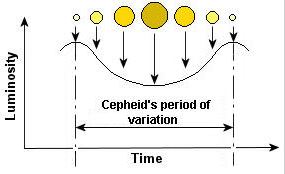Leavitt's
Period-Luminosity Relation
 http://www.angelfire.com/gail.bischoff/auit/variable.html
http://www.angelfire.com/gail.bischoff/auit/variable.html
-
- Calibration allowed the absolute
magnitudes of Cehieids to be logarithmically
quantified in large groups with the "Distance
Modulus" formula;
- With data from a pair of
Cepheids having the same period of variance,
"the one with the Greater average magnitude is
the star that is nearest to us" (Star).
- For Example:

red dots - Observations by the American
Association of Variable Star Observers, (AAVSO),
from July to December 2010 (NASA, 2011).
- The Hubble Telescope uses a
mirror that is 2.4 meters across to capture
images.
- We can determine how bright a
star in from its period thanks to Leavitt!
- Period = 31.4 days
- If the luminosity log-log plot
corresponds to aprox. 16,000 times the sun.
- Sun's luminosity =
Watts.
We can now find the distance to the
star using flux (F) =
(Flux: how much light is hitting each square meter
of our telescope)
and the Flux-Luminosity (L) relationship:
- Solving for distance we have:
- In light years that is
light years which is close to the accepted
distance reported in
|